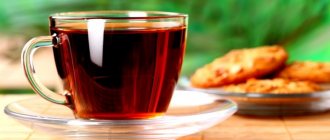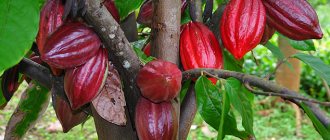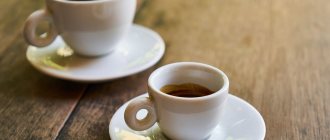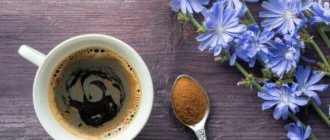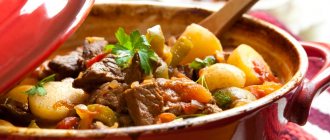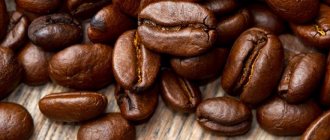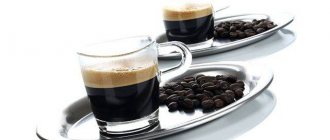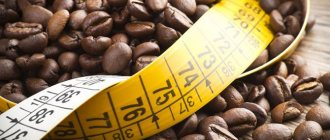The amount of caffeine in tea: what it depends on
Not only are alkaloids present in coffee blends, but natural tea leaves also contain them. The percentage of substrate they contain depends on many factors, such as variety, quality, preparation method and brewing time. The level of saturation ranges from negligible to quite impressive.
To a large extent, this depends on how selected the raw materials are chosen when manufacturing the product. The highest percentage falls on the top leaves, and as it decreases, the concentration of invigorating elements also decreases. On the lowest growing shoots there is less than 1%. You can easily recognize a good product on a store shelf - products made from tall-growing leaves are much more expensive than their analogues. For example, in “An Ji Bai Tea”, consisting only of the top leaves and buds, the caffeine content will be much higher than, for example, in the usual “Gunpowder”. So-called decaf teas are produced using the outermost leaves. It is worth noting that they also have their own percentage, although very small.
To understand whether tea or coffee has more caffeine, you need to know how the raw materials are processed. The fewer processing cycles it goes through, the better the product retains vitamins and other components, and the more intensely the elements that stimulate the nervous system are released. Based on this, we can conclude that the most saturated are green varieties, because they are the least processed. One serving can contain between 50 and 80 milligrams, which is almost more significant than the black varieties. These data show that green does not always mean a less dangerous and healthier product.
Where is the substance found?
The maximum concentration of this natural alkaloid is found in coffee beans. Caffeine is also found in other plants: tea, cocoa, holly, coca and guarana. A person, noticing the effect of certain fruits or leaves on the central nervous system, learned to prepare a drink from them. The tonic effect of different decoctions and infusions can be strong or mild depending on the level of alkaloid content.
Coffee
A cup of coffee contains 50-200 mg of caffeine. Such a wide range in numbers is due to the type of product. Natural beans contain the most active substance, so it is not advisable to drink freshly brewed coffee in the afternoon. Moreover, noble Arabica, having a richer taste and rich aroma, is almost two times inferior to robusta in terms of caffeine content: 100 mg versus 210 mg in a 200 g serving. The finer the grind , the higher the concentration of the substance.
- This is interesting: What is the difference between Arabica and Robusta
The instant option is less strong: a cup of instant coffee contains 50 mg of caffeine (per 200 ml). However, you should not give preference to a granulated or freeze-dried product because of this: along with caffeine, natural coffee beans contain minerals that instant coffee does not contain.
Decaf (decaffeinated coffee) is available in both natural and instant forms. About 3% of the substance still remains in the product. With gentle cleaning, the taste suffers only slightly.
Tea
Caffeine was discovered in tea leaves in 1827. At first it was called theine, but after 10 years it was proven that this is the same substance. Both names can be found.
It is impossible to answer unequivocally where there is more caffeine - in tea or coffee. The concentration of theine in tea greatly depends on the variety, place of growth, method of processing raw materials and preparing the drink: there is slightly more of it in black tea than in green tea (60-80 mg and 30-60 mg per cup, respectively). The hotter the water and the longer the contact of tea leaves with it, the more active substance is released. It is not recommended to brew for longer than 5 minutes.
Theine has a slightly weaker effect, but the stimulating effect is longer lasting.
- Need to know: Can I drink coffee after taking pills?
The concentration of the plant alkaloid mateine in mate tea, which is produced from the leaves and shoots of the Paraguayan holly, is 1.8%. But the drink is brewed unconcentrated, so it has a mild tonic effect. Moreover, matein not only invigorates, but also, oddly enough, improves the quality of sleep.
Other products
Cocoa beans also contain caffeine, but in smaller quantities. A cup of cocoa contains 50 mg.
Dark chocolate has a more pronounced tonic effect compared to milk chocolate, and white delicacy does not contain any alkaloid at all. 100 g of dark chocolate contains up to 90 mg of the substance, and the same bar of milk chocolate contains only 15-20 mg.
The world's most popular drink, Coca-Cola, also contains caffeine. It is also added to energy drinks in large quantities, equivalent to the concentration in espresso. Regular use may lead to sleep disturbances. Caffeine-alcohol cocktails are especially dangerous.
Table of caffeine content in various drinks
| Product | Amount of caffeine in 100 g of drink (mg) |
| Natural coffee (robusta) | 105 |
| Natural coffee (Arabica) | 50 |
| Black tea | 30-40 |
| Instant coffee | 25 |
| Green tea | 15-30 |
| Cocoa | 25-30 |
| Mate tea | 25-30 |
| Coca Cola | 10-12 |
https://www.youtube.com/watch?v=t-KF80wyYx8
Various additives partially neutralize caffeine in drinks: milk, spices (cinnamon, cardamom, ginger), cane sugar.
Cooking method also matters
Regardless of the grade, the level of caffeine alkaloid can be increased or decreased by brewing technique. It is released much more strongly from the mixture when high-temperature water is used. If you use a liquid that is not too hot, most of it is retained in the sheets. But this only works with green varieties; black cannot be cooked without boiling water, so it turns out more rich.
Concentration is of great importance: the more poured into the cup, the higher the level of active elements. The optimal amount for green is 4-7 grams per serving, and for black it is half as much. Although a lot depends on the leaves, many popular brands have different percentages for the same volume. The strength will be much lower if the composition contains many flavors.
Useful data
Initially, it was believed that the leaves and grains contained various tonic substances. In the first, alkaloids-tannins were isolated, and in the second, a full-fledged alkaloid-caffeine. Active tannins were discovered in tea leaves back in the 19th century, and were classified as a separate species.
Only 100 years later, scientists came to the conclusion that this is the same coffee alkaloid. But the effect on the body was different, so studies were conducted to find the reason for this difference. It turned out that “coffee” human activity is shorter, but more intense than “tea” activity. The brewed grains have a short-term stimulating effect, while the leaves are tonic for a long period of time, and in addition remove thirst and refresh. Thanks to these properties, tea drinking traditions have been popular throughout the world for thousands of years.
Useful information about tea caffeine
The caffeine contained in tea and coffee is a significant difference between them. And this is due to a number of factors.
The tonic crystals that make up the tea are scientifically called tannin. It was discovered at the beginning of the 19th century and was initially classified as a separate group of alkaloids. Only a century later, pure caffeine was extracted from tea leaves, and a few years later they came to the conclusion that it is the same as tannin. This finding led to the conclusion that tea and coffee contain the same caffeine. At the same time, the effect of drinks on the body is different, which means that something changes the effect of alkaloids.
You might be interested in Latte or latte - how to put the emphasis correctly
Over time, it turned out that the tannin in tea leaves partially blocks the effect of caffeine, so the effect of espresso, for example, and a Lipton cup varies. Drinking a cup of coffee makes a person feel cheerful, energetic and even happy. The sensation lasts about 30-40 minutes of caffeine action. After tea, the effect of invigoration is longer lasting, even despite the high level of concentration in the first drink.
Unlike coffee beans brewed in one way or another, tea is perfectly refreshing and helps to invigorate, quenching thirst. It is not for nothing that in some countries the tea drinking ceremony is a national tradition that has not become obsolete even after the discovery of the properties of coffee.
Where is the concentration higher: in tea leaves or coffee beans
If you consciously and moderately consume caffeine-containing products, their effect on the body will be positive. The main problem is that their impact on each person can vary significantly, depending on the individual and the condition. For some, half a cup of cappuccino is enough to cheer them up; for others, even two stronger espressos will not feel the effect. Therefore, it is necessary to understand the actual content of the stimulating elements in each type.
Find out how much caffeine is in a cup of tea and coffee from the detailed table below:
| Name | Cup volume in ml. | Content in mg. | |
| Coffee | Ground | 250 | 100-200 |
| Soluble | 80-100 | ||
| Decaf | 3-5 | ||
| Tea | Black | 45 | |
| Green | 70 | ||
Impact on the body
In small quantities, the substance has a stimulating effect on the body. The cardiovascular system reacts first: the heart rate increases and blood pressure rises. Therefore, the morning of hypotensive patients begins with a cup of coffee, and this drink is contraindicated for hypertensive patients. Then a surge of dopamine helps improve your mood. Following the heart, the central nervous system reacts to the substance: brain activity improves and physical performance increases.
- Don't miss: How coffee affects the human body
The nature of the effect on the body largely depends on the individual characteristics of the human nervous organization. Interactions with some medications are possible, so you may have to give up coffee and tea during treatment.
Caffeine enters the bloodstream 40-50 minutes after consumption. The effect of caffeine is 3-6 hours, so people sensitive to it should avoid invigorating drinks in the afternoon. Caffeine is completely eliminated from the body 14 hours after consumption.
In women, the elimination process is a little slower, and in smokers it is faster.
With regular, long-term use, a weak attachment to coffee or tea arises: without a cup of your favorite drink, it can be difficult to wake up and gather strength. From a medical point of view, caffeine is a drug, but due to its low concentration in products, there is no ban on drinking tea and coffee. Energy drinks with a substance concentration of more than 150 mg/l must contain a mention of possible harm to health and prohibition for children and pregnant women.
What drinks can be replaced
Ivan tea contains a minimal amount of alkaloids, but has a whole list of useful components. All of them have a beneficial effect on human health. The level of vitamins C and B in the mixture based on this plant is very high (even compared to oranges, lemon and other traditional sources). The composition also contains quickly digestible proteins, and the percentage of harmful acids (purine, uric, oxalic and others) is extremely low.
Other non-alkaloid herbal mixtures (based on linden and chamomile) also have beneficial properties, and their use has a positive effect on a person’s physical condition. You can prepare them yourself or purchase them at a pharmacy or specialty store. The search for alternative invigorating blends is simply necessary when the daily dose of consumption approaches the 1000 mark.
You can also highlight special products that are manufactured using the decaffeination procedure. These are ordinary mixtures with a minimum percentage of content. Some of the representatives of this line differ slightly in taste characteristics, and also have identical aroma and color. The cost and quality of a particular product will influence the product’s compliance with the classic options.
Caffeine in instant coffee
Is there caffeine in instant coffee? This type of coffee product is produced using modern machine technologies. These techniques are aimed at depriving the coffee bean of its special aroma and all taste characteristics, while the caffeine concentration remains at the original level. The raw materials for such products are low quality coffee varieties. For example, robusta. This variety does not have a pronounced taste, but is distinguished by its strong strength. The alkaloid is 5 times more concentrated than Arabica. Instant coffee contains up to 100 mg of caffeine per cup. Therefore, drinking such a drink is very dangerous for health. And the information about the absence of an alkaloid in the drink is false. Decaffeinated coffee in any case contains at least a minimal amount of it. To reduce this indicator, you need to dilute the drink with milk or cream. It is advisable to drink no more than 3 drinks per day.
What effect does it have on the human body?
As we have already said, the concentration in the finished coffee product depends on the brewing time. The longer the extraction takes place, the higher the percentage of alkaloid elements extracted. A person uses this to stimulate the nervous system and gain new strength. In people under such influence, an increase in heart rate, constriction of blood vessels, and acceleration of the pulse are observed. But the beneficial effect cannot be separated from the side effects, so you need to monitor the dosage of consumption. Exceeding the recommended dose of 4 g can negatively affect the functioning of the heart muscle and other internal organs.
Signs of exceeding the norm, harm
Despite all the positive aspects, caffeine can also be dangerous for the body. The dangers of regularly consuming caffeine-containing products are as follows:
- possible heart rhythm disturbance;
- the nervous system is exhausted
- dehydration occurs due to the diuretic effect;
- exhaustion of the adrenal glands, due to the “rush” of metabolism,
- has a laxative effect,
- the absorption of magnesium is impaired and the level of acid in the stomach increases, which can lead to peptic ulcers,
- promotes “leaching” of calcium from bones,
- contains acrylamide, which is a carcinogen,
- causes heartburn.
Caffeine poses the greatest danger to people with cardiovascular pathologies, since its effect not only stimulates the contraction of the heart muscle, but also the center of the vagus nerve, which leads to malfunctions of the heart muscle. Large doses of the drink can lead to arrhythmia.
If any unpleasant sensations occur after drinking the drink, such as irregular heart rhythm, dizziness, headaches or stomach pain, then tea should be excluded from your diet and consult a doctor immediately.
Caffeine content in tea and coffee - comparison table
| Name | Serving (ml/g) | Average content (mg) | |||
| Coffee | Natural | 250 | 170 | ||
| Soluble | 100 | ||||
| Decaf | 5 | ||||
| Espresso | 30 | 50 | |||
| Tea | Black | 250 | 45 | ||
| White | 55 | ||||
| Green | 70 | ||||
| Energetik | 85 | ||||
| Chocolate (dark) | 100 | 40 | |||
| Chocolate ice cream | 35 | ||||
| Lemonades and soda | 330 | 35 | |||
| Iced tea in bottles | 20 | ||||
| Hot chocolate | 240 | 10 | |||
All figures indicated in this table are average values and may differ either up or down. This depends on the specific name, quality of the product and method of preparation (we wrote about all these nuances above). The range between the maximum and minimum value can be up to 50%.
Other drinks containing caffeine
Cocoa and hot chocolate also contain caffeine. This explains their tonic effect. If the drink is quite fatty, then it contains a lot of caffeine. But this amount does not exceed 40 mg per cup. This alkaloid is also present in a chocolate bar made from natural cocoa beans. Energetic drinks. These drinks necessarily contain caffeine. Its quantity varies greatly among different manufacturers. Some companies use tricks to disguise this substance. But you shouldn't believe it. In energy drinks, the alkaloid content reaches 90 mg.
Caffeine content in various drinks, table
| Beverages | Caffeine content per 1 serving, volume mg. | Volume of 1 serving ml. | mg/ml content |
| Espresso | 50-68 | 25-35 | ~2 |
| Americano | 50-68 | 50-70 | ~1 |
| Cappuccino | 50-68 | 140-180 | ~0.35 |
| Black coffee | 38-65 | 100 | 0.38-0.65 |
| Instant coffee | 31-48 | 100 | 0.31-0.48 |
| Decaffeinated coffee | 3 | 100 | 0.03 |
| Black tea | 40-50 | 100 | 0.4-0.5 |
| Green tea | 20-30 | 100 | 0.2-0.3 |
| Coca Cola | 10,4 | 100 | 0.1 |
| Pepsi cola | 5,4 | 100 | 0.05 |
| Energy | 20-35 | 100 | 0.2-0.35 |
Comparison of content in different varieties
Black
In this product, the amount of tannin alkaloids can reach 70 mg (average 45) per serving. In this parameter, it is almost 3 times inferior to brewed ground coffee. But it is worth considering the degree of concentration of the mixture in the cup, as well as the duration of brewing and grade, because the values may vary depending on these factors. Note that in addition to stimulating crystals, this form contains useful antioxidants that have a beneficial effect on the vital functions of the human body. In combination with them, the effect becomes softer and longer lasting.
Green
The average values of the richest representative of tea products are 15-25 percent higher than those of the black counterpart. According to these criteria, it can compete even with soluble species, but subject to certain conditions. To achieve the maximum invigorating effect, we recommend increasing the brewing time and using varieties without flavorings. Thus, the strength will be further increased.
White
There is a common myth that this variety does not contain alkaloids, and its content of beneficial antioxidants is higher than anywhere else. However, this is a misconception, because there are many white varieties in which the spread is very large. One cup can contain between 15 and 75 mg. Therefore, it is difficult to assign this variety a position in the list relative to its brothers. Nominally we place it between black and green, taking into account the average values.
Decaf
The name of this species is not entirely correct, because it still contains its own share of caffeine, although not as significant as in the classic subspecies. Modern methods of extracting alkaloids from a mixture do not allow one hundred percent to get rid of them. Therefore, one serving of 250 ml accounts for about 0.005 grams.
Advantages and Disadvantages of Quitting Caffeine
Caffeine is only effective if you consume it only occasionally. But if you are a daily coffee drinker, you will start to feel uncomfortable when you give it up.
Headache, decreased activity, insomnia are the consequences of abrupt caffeine withdrawal. Usually such symptoms disappear after three to four days.
Conclusion
The amount of caffeine depends on the quality of the product and the brewing method. As you can see from the caffeine content table, instant coffee generally does not contain much more caffeine than black tea. When taking energy drinks, the effect of caffeine becomes more pronounced.
You need to understand that the amount of active alkaloid in coffee beans depends on their variety, place of origin, and soil where the crop was grown.
Additionally, the amount of caffeine in a flavored drink is affected by:
- degree of roasting;
- naturalness;
- cooking method.
The table shows caffeine levels for different types of coffee that are in greatest demand.
| Type of coffee beans | Amount of caffeine per cup (170 g), mg |
| Ethiopian "Mocha" | 160 |
| "Santos" | 160 |
| "Minas" | 163 |
| "Peru" | 170 |
| "Costa Rica" | 170 |
| "Mexican" | 170 |
| "Arabica" | 177 |
| "Nicaragua" | 180 |
| "Cameroon" | 180 |
| "Guatemala" | 187 |
| "Salvador" | 187 |
| "Javanese Arabica" | 187 |
| "Venezuela" | 192 |
| "Colombia" | 195 |
| "Cuban" | 195 |
| Indian "Meleber" | 195 |
| Haitian | 201 |
| Robusta from Congo | 325 |
| "Robusta from Uganda | 325 |
As for the degree of roasting of the bean, the amount of caffeine increases with increasing heat treatment. The lighter the beans, the less caffeine they contain. That is why espresso is brewed from the darkest, deep-roasted beans.
Regarding naturalness, it is worth noting that instant coffee is not as strong as natural coffee brewed from freshly ground beans. The amount of caffeine in it is about 60 mg per 170 ml of liquid.
The method of preparation also matters. A drink brewed in a Turk will be less strong than one passed through a coffee machine, where the beans undergo prolonged extraction, saturating the water with active substances as much as possible. A cup (170 ml) of coffee brewed in a Turk based on strong or medium roast beans contains about 115 mg of caffeine.
Natural coffe
Answering the question of how much caffeine is in a cup of green and black tea, we can say – less than in coffee drinks. It is a mistake to think that a high concentration of alkaloids is a sign of a good product. The best varieties have a lower percentage. For example, between mocha and robusta the difference in richness can be almost twofold. If we take the average values, then there will be 0.17 g in one serving. The safest (from a medical point of view) method of preparation is as follows:
- Take 20-30 grams of coffee.
- Pour 200-250 milliliters of boiling water.
- Heat until boiling.
The aroma and taste will not change, but the risk of obtaining increased concentrations is reduced. There will be an optimal dosage that will not harm your health.
History of the discovery of caffeine
According to one legend, the discovery of the effects of coffee was accidental. In the 9th century, an Ethiopian shepherd noticed that his goats began to jump wildly after eating the leaves and fruits of a wild tree. The shepherd told about this to the abbot of the local monastery, who took the risk of trying this mysterious plant himself. Later, drinking a decoction of the leaves and fruits of the coffee tree became a tradition of this monastery, because thanks to this drink the monks felt more cheerful during night services. By the way, the name “coffee” comes from the name of the Ethiopian province of Kafa.
Much later, in 1819, Friedlieb Ferdinand Runge, a German chemist, isolated silky colorless crystals from an extract of coffee beans, with a bitter aftertaste, the aqueous solution of which was many times superior to coffee decoction in its invigorating qualities. This element, which is a subtype of alkaloids, received the name caffeine because it was isolated from it, although it is also found in other plants. It is also called theine, mateine or guaranine. In addition to coffee, caffeine is found in tea leaves, cocoa beans, mate leaves and shoots, and the guarana climbing vine (the fruits of which have twice the caffeine content of coffee beans).
Soluble
In this case, everything depends on the specific manufacturer, brand and quality of the original raw materials. For this variety, inexpensive varieties are taken, and the grains themselves are selected smaller; substandard ones are often used. Different blends will also reduce the saturation, so for one cup of freeze-dried product the average will be 100 mg. But these figures contain an error factor, because on the market there are both very high-quality brands and outright imitation of natural products.
Where is there more caffeine?
Processed grains and leaves can have completely different effects on the body, depending on the presence of additional impurities and the individual characteristics of the person. Identical numbers on paper do not guarantee an identical effect, because the consumer’s reaction will depend on many factors. For example, brewing time, quantity of mixture and quality of product.
If we compare the amount of caffeine in tea and coffee, the second option will always be more saturated with invigorating microelements. If your goal is to quickly increase activity (physical and mental), then we recommend using a more intense option. To raise your tone for a long time, you can hold a tea ceremony. In addition, this minimizes the risk of exceeding the therapeutic norm.
Instant or natural coffee: who wins?
When it comes to nutrients, the clear leader is coffee beans. In addition to caffeine, it contains fatty acids that fight cancer cells, as well as significant amounts of potassium and magnesium. Instant coffee cannot boast of this.
But if we are talking about caffeine, then the indicators are almost the same (per 100 ml):
- in a cup of instant coffee about 30-50 mg;
- in a cup of natural - from 40 to 70 mg.
Amount of caffeine in instant coffee of different brands
Separately, it is worth mentioning coffee drinks with the addition of milk (for example, latte, cappuccino, etc.) and the popular Americano and espresso. You will be surprised, but they contain more caffeine than regular black coffee (a reason to think about it for those who like “foam”):
- cappuccino - about 50-70 mg (per 150-200 ml of drink);
- Americano - about 48-68 mg (per 60-70 ml of drink);
- espresso - about 48-68 mg (per 30-40 ml).
Advice. If you are a coffee lover (we are talking about a natural product), then you should definitely know the maximum permissible daily dosage of this drink - 4 cups. Exceeding this figure guarantees you a “bouquet” of side effects: migraines, convulsions, tremors of the limbs, nausea, tachycardia, etc.
Conclusion
We have studied in detail all popular products containing elements that stimulate the nervous system. It is very important to control the level of their consumption and avoid significant overdose. You should study the effect of different types of products on your condition and draw up individual limits for consumption.
When calculating the average content, you can be guided by the table we provided above. However, it is worth taking into account the type, variety and quality of a certain brand, as well as the method and duration of brewing. Note that the caffeine in coffee and tea produces different effects in comparison. In the first case, the effect is short-term, but intense, and in the second, a much milder and longer-lasting effect is observed.
Don’t forget about the variety of actions in combination with additives and flavorings. They can either enhance or weaken the stimulating effect on the central nervous system.
